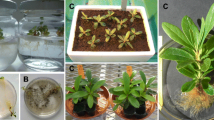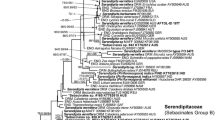Summary
A correlated light and electron microscopic study was undertaken of the initiation and development of root nodules of the actinorhizal tree species,Elaeagnus angustifolia L. (Elaeagnaceae).
Two pure culturedFrankia strains were used for inoculation of plants in either standing water culture or axenic tube cultures. Unlike the well known root hair infection of other actinorhizal genera such asAlnus orMyrica the mode of infection ofElaeagnus in all cases was by direct intercellular penetration of the epidermis and apoplastic colonization of the root cortex. Root hairs were not involved in this process and were not observed to be deformed or curled in the presence of the actinomyceteFrankia. In response to the invasion of the root, host cells secreted a darkly staining material into the intercellular spaces. The colonizingFrankia grew through this material probably by enzymatic digestion as suggested by clear dissolution zones around the hyphal strands. A nodule primordium was initiated from the root pericycle, well in advance of the colonizingFrankia. No random division of root cortical cells, indicative of prenodule formation was observed inElaeagnus. As the nodule primordium grew in size it was surrounded by tanninised cells of a protoperiderm. The endophyte easily traversed this protoperiderm, and once inside the nodule primordium cortex ramified within the intercellular spaces at multiple cell junctions. Invasion of the nodule cortical cells occurred when a hyphal branch of the endophyte was initiated and grew through the plant cell wall, again by apparent enzymatic digestion. The plant cell plasmalemma of invaded cells always remained intact and numerous secretory vesicles fused with it to encapsulate the advancingFrankia within a fibrous cell wall-like material. Once within the host cell some endophyte cells began to differentiate into characteristic vesicles which are the presumed site of nitrogen fixation. This study clearly demonstrates that alternative developmental pathways exist for the development of actinorhizal nitrogen-fixing root symbioses.
Similar content being viewed by others
References
Angulo Carmona, A. F., 1974: La formation des nodules fixateurs d'azote chezAlnus glutinosa (L.) Vill. Acta Bot. Neerlandica23, 257–303.
—,van Dijk, C., Quispel, A., 1976: Symbiotic interactions in non-leguminous root nodules. In: Symbiotic nitrogen fixation in plants (Nutman, P. S., ed.), pp. 474–484. Cambridge: Cambridge University Press.
Baker, D., Newcomb, W., Torrey, J. G., 1980: Characterization of an ineffective actinorhizal microsymbiont,Frankia sp. EuI l (Actinomycetales). Can. J. Bot.26, 1072–1089.
—,O'Keefe, D., 1984: A modified sucrose fractionation procedure for the isolation of frankiae from actinorhizal root nodules and soil samples. Plant and Soil78, 23–28.
Benson, D. R., Hanna, D., 1983:Frankia diversity in an alder stand as estimated by sodium dodecyl sulphate-polyacrylamidc gel electrophoresis of whole-cell proteins. Can. J. Bot.61, 2919–2923.
Berry, A. M., 1984: The actinorhizal infection process: review of recent research. In: Current perspectives in microbial ecology (Klug, M. J., Reddy, C. A., eds.), pp. 222–229. Washington: Amer. Soc. Microbiology.
—,Torrey, J. G., 1983: Root hair deformation in the infection process ofAlnus rubra. Can. J. Bot.61, 2863–2876.
Bond, G., 1951: The fixation of nitrogen associated with the root nodules ofMyrica gale L., with special reference to its pH relation and ecological significance. Ann. Bot.15, 447–459.
Callaham, D., Newcomb, W., Torrey, J. G., Peterson, R. L., 1979: Root hair infection in actinomycete-induced root nodule initiation inCasuarina, Myrica andComptonia. Bot. Gaz.140, S1-S9.
—,Torrey, J. G., 1977: Prenodule formation and primary nodule development in roots ofComptonia (Myricaceae). Can. J. Bot.55, 2306–2318.
Chandler, M. R., 1978: Some observations on infection ofArachis hypogaea byRhizobium. J. exp. Bot.29, 749–755.
—,Date, R. A., Roughley, R. J., 1982: Infection and root-nodule development inStylosanthes species byRhizobium. J. exp. Bot.33, 47–57.
Duhoux, E., 1984: Ontogénèse des nodules caulinaires duSesbania rostrata (légumineuses). Can. J. Bot.62, 982–994.
Fletcher, W. W., 1955: The development and structure of root-nodules ofMyrica gale L. Ann. Bot.19, 501–513.
Kant, S., Narayana, H. S., 1977: Preliminary studies on the development and structure of root nodules inCasuarina equisetifolia L. Proc. Indian Acad. Sci. B.85, 34–41.
Knowlton, S., Berry, A., Torrey, J. G., 1980: Evidence that associated soil bacteria may influence root hair infection of actinorhizal plants byFrankia. Can. J. Bot.26, 971–977.
—,Dawson, J. O., 1983: Effects ofPseudomonas cepacia and cultural factors on the nodulation ofAlnus rubra roots byFrankia. Can. J. Bot.61, 2877–2882.
Lalonde, M., 1977: Infection process of theAlnus root nodule symbiosis. In: Recent developments in nitrogen fixation (Newton, W., Postgate, J. R., Rodriguez-Barrueco, C., eds.), pp. 569–589. London: Academic Press.
Lancelle, S. A., Torrey, J. G., 1984: Early development of Rhizobium-induced nodules ofParasponia rigida. I. Infection and early nodule initiation. Protoplasma123, 26–37.
Pommer, E. H., 1956: Beiträge zur Anatomie und Biologie der Wurzelknöllchen vonAlnus glutinosa Gaertn. Flora143, 603–634.
Strand, R., Laetsch, W. M., 1977: Cell and endophyte structure of the nitrogen-fixing root nodules ofCeanothus integerrimus H. and A. II. Progress of the endophyte into young cells of the growing nodule. Protoplasma93, 179–190.
Taubert, H., 1956: Über den Infektionsvorgang und die Entwick-lung der Knöllchen beiAlnus glutinosa Gaertn. Planta48, 135–156.
Torrey, J. G., 1976: Initiation and development of root nodules ofCasuarina (Casuarinaceae). Amer. J. Bot.63, 335–344.
—,Callaham, D., 1979: Early nodule development inMyrica gale. Bot. Gaz.140, S 10-S 14.
Author information
Authors and Affiliations
Rights and permissions
About this article
Cite this article
Miller, I.M., Baker, D.D. The initiation, development and structure of root nodules inElaeagnus angustifolia L. (Elaeagnaceae). Protoplasma 128, 107–119 (1985). https://doi.org/10.1007/BF01276333
Received:
Accepted:
Issue Date:
DOI: https://doi.org/10.1007/BF01276333




